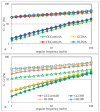Selected Physicochemical, Thermal, and Rheological Properties of Barley Starch Depending on the Type of Soil and Fertilization with Ash from Biomass Combustion
- PMID: 38201077
- PMCID: PMC10778105
- DOI: 10.3390/foods13010049
Selected Physicochemical, Thermal, and Rheological Properties of Barley Starch Depending on the Type of Soil and Fertilization with Ash from Biomass Combustion
Abstract
The following study analyzed the impact of fertilizing barley with fly ash from biomass combustion grown on two types of soil, Haplic Luvisol (HL) and Gleyic Chernozem (GC), on the properties of starch. The experiment was conducted in 2019 (A) and 2020 (B), and barley was fertilized with ash doses (D1-D6) differing in mineral content. In the tested barley starch samples, the amylose content, the clarity of the paste, and the content of selected minerals were determined. The thermodynamic characteristics of gelatinization and retrogradation were determined using the DSC method. Pasting characteristics, flow curves, and viscoelastic properties of starch pastes were performed. Starches differed in amylose content and paste clarity. The highest gelatinization and retrogradation enthalpy (ΔHG and ΔHR) values were recorded for samples GCD1A and HLD5B. None of the tested factors significantly affected the pasting temperature (PT), but they had a significant impact on the remaining parameters of the pasting characteristics. The average PT value of barley starches was 90.9 °C. However, GCD2A starch had the highest maximum viscosity and the highest rheological stability during heating. GCD2A paste was characterized by the highest apparent viscosity. It was shown that all pastes showed non-Newtonian flow and shear-thinning and had a predominance of elastic features over viscous ones. The resulting gels had the characteristics of weak gels. Ash from burning wood biomass is an innovative alternative to mineral fertilizers. It was shown that the use of such soil fertilization influenced the properties of barley starch.
Keywords: ash from biomass combustion; barley starch; fertilization; rheological properties; soil; thermal properties; viscosity.
Conflict of interest statement
Author Renata Pawlak was employed by the company RENAGRO Renata Pawlak. Renata Pawlak contributed to the “resources” section. All authors declare that the research was conducted in the absence of any commercial or financial relationships that could be construed as a potential conflict of interest.
Figures





Similar articles
-
Effect of Soil Type and Application of Ecological Fertilizer Composed of Ash from Biomass Combustion on Selected Physicochemical, Thermal, and Rheological Properties of Potato Starch.Molecules. 2022 Jul 5;27(13):4318. doi: 10.3390/molecules27134318. Molecules. 2022. PMID: 35807561 Free PMC article.
-
Physicochemical, thermal and rheological properties of starches isolated from malting barley varieties.J Food Sci Technol. 2015 Aug;52(8):4797-807. doi: 10.1007/s13197-014-1531-3. Epub 2014 Sep 7. J Food Sci Technol. 2015. PMID: 26243900 Free PMC article.
-
Physicochemical and Gelatinization Properties of Starches Separated from Various Rice Cultivars.J Food Sci. 2015 Oct;80(10):E2208-16. doi: 10.1111/1750-3841.13071. Epub 2015 Sep 9. J Food Sci. 2015. PMID: 26352343
-
Barley starch: Structure, properties and in vitro digestibility - A review.Int J Biol Macromol. 2020 Jul 15;155:868-875. doi: 10.1016/j.ijbiomac.2019.11.219. Epub 2019 Nov 28. Int J Biol Macromol. 2020. PMID: 31786300 Review.
-
Developments in the isolation, composition, and physicochemical properties of legume starches.Crit Rev Food Sci Nutr. 2021;61(17):2938-2959. doi: 10.1080/10408398.2020.1791048. Epub 2020 Aug 6. Crit Rev Food Sci Nutr. 2021. PMID: 32758002 Review.
Cited by
-
Fermentation Efficiency and Profile of Volatile Compounds in Rye Grain Mashes from Crops Fertilised with Agrifood Waste Ashes.Molecules. 2025 Aug 2;30(15):3251. doi: 10.3390/molecules30153251. Molecules. 2025. PMID: 40807426 Free PMC article.
References
-
- Rasmusson D.C. Barley. American Society of Agronomy, Crop Science Society of America, Soil Science Society of America; Madison, WI, USA: 2015. Agronomy Monographs. - DOI
Grants and funding
LinkOut - more resources
Full Text Sources
Research Materials
Miscellaneous

